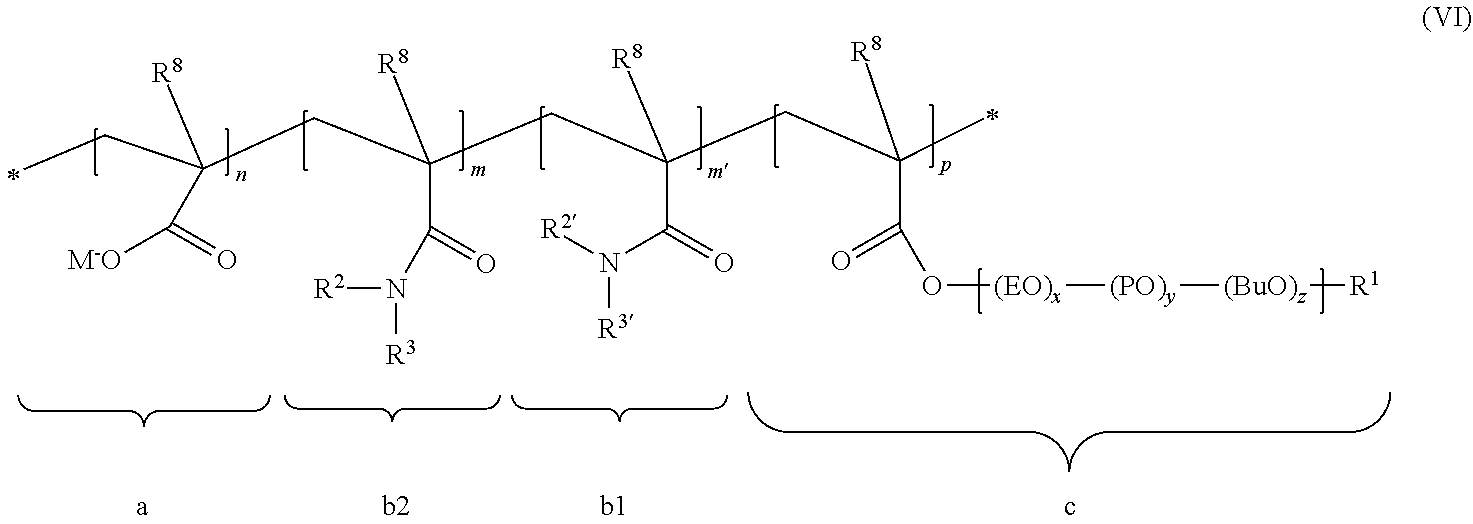Process for producing polymers having amide and ester groups in the solid state
a technology of ester group and solid state, which is applied in the field of group of amides and esters of polymers of unsaturated carboxylic acids, can solve the problems of unfavorable crosslinking of polymers, increased polyether cleavage of side chains, and complicated further reactions, etc., and achieves the effect of convenient modification
- Summary
- Abstract
- Description
- Claims
- Application Information
AI Technical Summary
Benefits of technology
Problems solved by technology
Method used
Image
Examples
example 1
[0088]500 g of silicic acid are introduced into a Hobart mixer and 215 g of ethanolamine are added with gentle stirring. The mixture is mixed for a further 5 minutes and then introduced into a glass bottle. The readily flowable powder contains about 30% of ethanolamine. Designation: AT1
[0089]550 g of solid polymer BP1 are introduced into a porcelain ball mill and 60 g of AT1 are mixed therewith. This mixture thus contains about 18 g of ethanolamine. This mixture is milled with addition of steel balls for 12 hours. The fine white powder obtained is filled. Designation: EPA1
example 2
[0090]Before solidification, the polymer BP1 is poured onto a flat substrate at about room temperature. AT1 powder is sprinkled onto the supercooled melt at a temperature of less than 60° C., in an amount of about 60 g of AT1 powder per kg of polymer melt. The polymer then solidifies to give a solid, which is comminuted to give small pieces, in particular scales. The small pieces are then processed by means of a mill to give a powder. Designation: EPA2.
[0091]After the powder has been allowed to stand for 1 to 2 days, it is possible to show that the polymer treated with amine has properties differing from those of the untreated polymer.
[0092]Exemplary Hydraulically Setting Compositions
[0093]The efficiency of the polymers according to the invention was tested in mortar.
[0094]
Composition of mortar mix 1: MM1 (largest particles 8 mm)AmountCement (Swiss CEM I 42.5)750 gLimestone filler141 gSand 0-1 mm738 gSand 1-4 mm1107 g Sand 4-8 mm1154 g
[0095]The sands, the filler and the cement and ...
PUM
| Property | Measurement | Unit |
|---|---|---|
| temperature | aaaaa | aaaaa |
| temperature | aaaaa | aaaaa |
| temperature | aaaaa | aaaaa |
Abstract
Description
Claims
Application Information
 Login to View More
Login to View More - R&D
- Intellectual Property
- Life Sciences
- Materials
- Tech Scout
- Unparalleled Data Quality
- Higher Quality Content
- 60% Fewer Hallucinations
Browse by: Latest US Patents, China's latest patents, Technical Efficacy Thesaurus, Application Domain, Technology Topic, Popular Technical Reports.
© 2025 PatSnap. All rights reserved.Legal|Privacy policy|Modern Slavery Act Transparency Statement|Sitemap|About US| Contact US: help@patsnap.com



